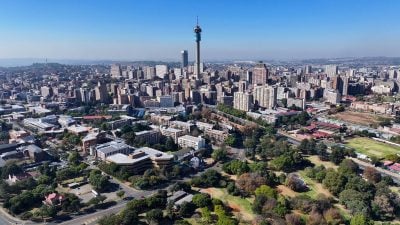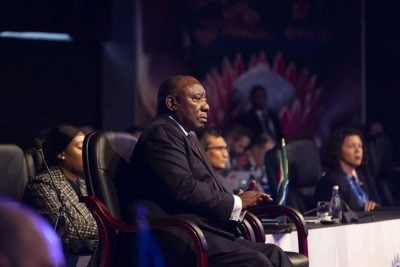We meet with Benedict Oramah at four o’clock on a Saturday afternoon at the Grove Hotel in Watford, a suburban town an hour north of London.
He had landed that morning and was in town to attend a wedding that evening. Since landing he has spent the whole day attending meetings and other work engagements, which meant skipping lunch (to the chagrin of his special advisor who accompanied us during the interview).
Oramah is a man in a hurry and on a mission. He took over the leadership of the Bank from Jean-Louis Ekra, who he had worked with and remains regularly in touch. Both are held in high regard in the industry but those who have worked with them say they have very different management styles.
Jean-Louis had exacting standards but let you run with ideas and projects. Oramah is at you continuously, sending emails at all hours of the day requesting progress reports and results. The Bank’s role has grown significantly in size and scope.
There were two defining moments: the first was during the global financial crisis and the second was during the more recent commodity price slump; either could have been fatal for Africa but the Bank played a pivotal role.
Oramah says the Bank has expanded its activities, not because it has increased its mandate but rather, it has been a natural progression and the Bank is simply executing what it has been set up to do, that is, promote African trade and value addition.
Oramah, who obtained a PhD in Agricultural Economics from Ife University – coincidentally, he and Akinwumi Adesina, President of the African Development Bank (AfDB), share the same PhD theme, and had the same professor – is a student of history and is keen to remind me of the reason behind the founding of Afreximbank.
Africa, he says, suffered its worst economic crisis in the 1980s in large part because of the withdrawal of international banks from the money markets. Following on from the debt crisis in Mexico, Brazil and Argentina, banks withdrew from Africa.
This was compounded by falling commodity prices which quickly created a backlog of trade payment obligations. Without new inflows, countries went into default. The rest is history.
The Bank, he says, was created to achieve an orderly adjustment to clear backlogs and give companies and countries time to adjust themselves, providing them with a horizon to pay off debts.
That was effectively repeated during 2016/17, which saw a fall in the price of commodities and other natural resources. “If one country defaults, the whole continent carries that stigma,” Oramah says. “We intervened very aggressively and that’s the difference between today and the 1980s.”
Countercyclical trade liquidity facility
To deal with the commodity downturn of the last two years, the Bank created a countercyclical trade liquidity facility, through which it disbursed $9bn. Most of it has been repaid, he says, with the remaining $1.5bn or so to come by the end of June.
“When I took over [in 2015], I was faced with this crisis. But I saw it as an opportunity to demonstrate the relevance of the Bank and I feared that if we failed to do something here, that could be the end of Afreximbank.
“We put together a countercyclical trade liquidity facility which was a bold intervention and it turned out to be a game-changer for the Bank. Not only did it double the balance sheet of the Bank, it brought in tremendous shareholder support and, in less than 18 months, it attracted 12 new member countries; if you include those who want to join, whose signatures we are awaiting, we are now at 51 members.”
The latest members to sign up are Russia and Belarus internationally, and in Africa, the South Africans have signed up through the Export Credit Insurance Corporation of South Africa (ECIC). Equatorial Guinea and Republic of Congo are finalising the paperwork and will be signed-up members soon, he says.
The Bank’s balance sheet stands at some $16bn and shareholder capital at a little over $3bn. When it put together its five-year plan (2017-2021), the targets it had set itself were $17bn and $3.5bn respectively.
When asked what he expects the figures to be by the end of 2021, he says that the five-year plan has not changed, although there will be a mid-term review of those targets.
More interesting possibly is the emphasis on domestic resource mobilisation. The Bank is reaching out to central banks through its Central Bank Deposit Programme. “It is well known that central banks are sitting on almost $500bn of reserves, and, in general, these are held outside [Africa] – financing US and European debt.”
Paradoxically, Oramah says, it is those same countries that tell their banks that it is too risky to lend to Africa, and who subsequently withdraw their credit lines to the continent for compliance reasons.
“We need to make African money work for Africa.” In a little over a year the Bank has managed to mobilise $5.4bn, with 19 central banks on board. This has halved the cost of funds, enabling the Bank to lend at more competitive rates, Oramah says. “The big economies are supporting this and we will see others follow suit.”
By ‘big economies’, he means Nigeria, Egypt and Angola. The target is to mobilise $10bn by the end of 2021, and he is confident of achieving this.
Rapid expansion
The Bank’s staff has also increased rapidly, doubling in the last five years from under 100 in 2012 to over 200 today. Oramah explains that the timing was right for the Bank to expand its activities to fulfil the mandate of its founding fathers – to promote intra-African trade and expand value added exports.
The shock of the 1980s, he says, had persuaded Ministers of Finance to create a pan-African Exim bank that would support their banks in trade finance. The rationale was that given its supranational status, it would be able to draw on international capital and, because it was staffed by Africans, it would have the expertise best suited to understanding the market. When they started the Bank, he says, it had to build a track record and credibility in the market.
When the current strategy was designed, he says, the aim was to go straight to the heart of the matter that had led to the establishment of the institution in the first place.
“The moment we opened up shop, we dealt with the immediate issues of the day – which was to give access to trade finance, as international banks had withdrawn. Twenty years later, when we were designing the latest strategy, we could not say with full confidence that we had done everything that the founding fathers had in mind.
“We were supposed to promote intra-African trade; we were supposed to promote export diversification. So when we had a retreat in 2016 we decided this was the time. In the strategy that started in 2017, we had to become more transformational and use trade to drive this transformation. I have never seen a country that has not developed from a trade-led strategy.”
Trade always at the centre
He believes that trade is at the centre of everything, even in terms of infrastructure, since without trade, the bankable projects will simply not exist. And without bankable projects, it will be impossible to crowd in private sector capital for the PPPs, or private sector infrastructure projects.
“China is the only country that has the money to build [infrastructure] and say business will follow. We are capital-scarce in Africa and we cannot adopt that rationale. Business needs to drive investment. If I’m building a railway to connect Ghana and Nigeria, I need to see that people are going to use it. Private sector [capital] will follow if you provide the business case.”
Everything the Bank is focused on today is geared towards boosting intra-African trade and extra-Africa trade. In this regard, the most talked-about issue in the public discourse, when it comes to economic diversification, is industrialisation.
On this front, the Bank is working with several countries to improve what Oramah calls their dynamic comparative advantage. Alongside China Exim, the Bank is helping to build industrial parks and Special Economic Zones, in which Chinese and African companies can collaborate.
“Our comparative advantage is our labour costs,” he says, “and we have identified light manufacturing as a sector of interest.” China Exim has put $1bn towards this project, part of the $60bn the Chinese pledged towards African industrialisation in 2016 at the FOCAC conference in Johannesburg.
He estimates that Africa, today, imports $60bn worth of light manufacturing goods from China. And if China is moving away from light manufacturing – and delocalising 85m jobs – it is now or never for Africa to take advantage of the opportunity.
But Afreximbank’s work is much more extensive. It is also developing testing and inspection centres for quality certification for export products. One of the constraints on the volume of African goods in global trade is the issue of certification. The Bank has brought in an international company to conduct the study; that company is now considering opening offices in Africa because it had not anticipated the size of the market.
“We are also trying to establish a centre of excellence in healthcare,” says Oramah. “If we show that it’s doable, we will then create a reaction and get others to follow suit.”
Oramah points out that some have dubbed Afreximbank an ‘interventionist bank’ but that does not bother him, as long as he can disprove the naysayers.
Pan-African payment settlement system
One of the more interesting projects the Bank is involved in is the development of a pan-African payment and settlement platform. The objective of the platform is to reduce the foreign currency content of payments for intra-African transactions. What the platform will do is enable buyers of goods within Africa to do so in their own currencies and the supplier of the goods to receive payment in their own currencies.
The pilot, which will go live by the end of the year, will cover six countries of the West African Monetary Union. Once there is proof the concept works, it will be rolled out to the rest of the continent. Oramah says the telcos and the stock exchanges have already expressed interest in this platform and he believes that once operational, there will be a tendency towards zero use of foreign currency.
“Everything will be settled in a two-stage clearing process, within country first and then across. Apart from reducing the foreign currency content it will bring back the trade that is currently being diverted. You have 55 countries and apart from the CFA zone, virtually all have their own currencies.
“When they want to do a bilateral trade settlement, they use a third currency, a hard currency. And that
has diverted intra-regional trade to extra-regional, and it has meant countries favouring exporting to Europe or elsewhere.”
Using big data, the platform will also capture trade finance flows and help companies build credit history and track records, enabling them to tap into more capital to finance trade or investment.
The Bank is trying to build some intra-African champions: companies it has identified that can drive economic diversification and those that will be responsible for aggressively driving intra-African trade. It supports such companies by providing them with finance facilities.
For example, the Bank has provided the Dangote Group with a $1bn facility, the Loukil Group in Tunisia with $150m and ElSewedy in Egypt with a $500m facility. There are over 10 companies amongst their Trade Champions and these facilities, he says, will help them bid for projects in other African countries, providing them advance payment guarantees, or help them finance trade and investment activities.
“Every time we get invited by a government,” Oramah adds, “I always try and go with the intra-African Trade Champions. The governments can then share investment opportunities with them, and projects where they are looking for partners.” He estimates that last year, Afreximbank helped these companies gain $2bn worth of contracts.
Is the Bank not overextending itself? Oramah does not seem to think so. If anything, he feels that it needs to be bolder and faster. He has set his team a target
of executing deals within a 12-week turnaround period – a bit longer for project finance, which is more complex.
He also wants to do more in terms of syndication. “One of the roles of the Bank is to attract international finance into Africa. We have a deal pipeline of about $50bn but we have limitations due to our capital and other prudential limits. The role of syndication is not to allow those limitations to stop [us] from supporting our countries.”
Last year, for every dollar the Bank lent, it attracted a further $3. But the target, he says, is to reach a $4 level – in effect, to lend a total of $5 for every dollar the Bank finances. “Our role is to do more than just lend. Our mandate is to promote, facilitate and finance,” he stresses.
When asked about current debt levels across Africa, he appears quite relaxed. He feels that the debt levels are manageable and, with the uptick in the price of commodities, servicing the debt should not put too much stress on the countries concerned. But he does call for caution. With regard to the Bank’s own balance sheet, he also feels it is operating well within its means. They are meeting the ratings agencies, he tells me, so that they understand what the Bank is doing, following its rapid expansion.
He favours a ratings target of between BBB and A. “We don’t want to be AAA as that would be too constraining for the kind of things that the Bank was founded to do: a rating target between BBB and A makes you respectable without the burden of having to abandon certain things that we have to do,” he adds with a smile.
When asked how he spends his time, he says that when he’s not travelling and in Cairo – the Bank’s headquarters – it’s on strategy. Last year the focus was on expanding membership. For him, it’s a network bank and the Bank must reach all African countries.
This year, he’s focused on the strategic initiatives that will define whether the Bank is on track. “We have tried to turn the Bank into a place where someone who has a purpose in life fulfils that purpose – and that is solving the major problems that the continent has.
There are a few things that Africans have talked about for too long and [working here] is being part of a team which is doing things to overcome these problems. Go to the office at 22.00 and you would think it’s 14.00, everyone driving the different activities of the Bank.” Let’s hope they serve lunch (and dinner!).
Cover and featured images by Andy Tyler
Want to continue reading? Subscribe today.
You've read all your free articles for this month! Subscribe now to enjoy full access to our content.
Digital Monthly
£8.00 / month
Receive full unlimited access to our articles, opinions, podcasts and more.
Digital Yearly
£70.00 / year
Our best value offer - save £26 and gain access to all of our digital content for an entire year!
 Sign in with Google
Sign in with Google 


